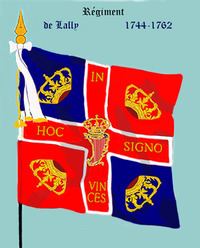Type Infantry | ||
 | ||
Allegiance Charles II of England & France | ||
The Clare's Regiment, later known as Clare's Dragoons, was initially named O'Brien's Regiment after its originator Daniel O'Brien, 3rd Viscount Clare raised a mounted dragoon regiment during the Jacobite war. When Clare’s Dragoons left Limerick with the Flight of the Wild Geese they became a regiment of infantry. Clare's Dragoons remained loyal to the dethroned James II of England and fought against the army of William III of England, during the Williamite War in Ireland.
Contents
- Clare s dragoons
- Clares regiments fate the 5th Regiment of Foot
- The Irish Brigade
- The Wild Geese
- Irish regiment in French service
- volution of the rgiment
- Combats et batailles
- Clares Dragoons song
- References
Clare s dragoons
Clare's regiment's fate, the 5th Regiment of Foot
On 1 July 1751 a royal warrant provided that in future regiments would not be known by their colonels' names, but by their "number or rank". Accordingly Lieutenant-General Irvine's Regiment was redesignated as the 5th Regiment of Foot.
The Irish Brigade
The Irish Brigade was a brigade in the French army composed of Irish exiles. It was formed in May 1690 when five Jacobite regiments were sent from Ireland to France in return for a larger force of French infantry who were sent to fight in the Williamite war in Ireland. The Irish Brigade served as part of the French Army until 1792. These five Jacobite regiments, comprising about 5000 men, were named after their colonels: Lord Mountcashel, Butler, Feilding, O'Brien and Dillon. They were largely inexperienced and the French immediately disbanded Butler's and Feilding's, either incorporating their men into the remaining three regiments or sending them back to Ireland. The remaining three regiments, Mountcashel's, O'Brien's and Dillon's, formed the Irish Brigade which served the French during the remainder of the Nine Years War (1689–97).
The Wild Geese
Under the terms of the Treaty of Limerick signed in October 1691, which ended the war between King James II and VII and King William III in Ireland, a separate force of 12,000 Jacobites arrived in France in an event known as Flight of the Wild Geese. These were kept separate from the Irish Brigade and were formed into King James's own army in exile, albeit in the pay of France. Lord Dorrington's regiment, later Rooth or Roth, following the Treaty of Ryswick in 1698, was formed from the former 1st and 2nd battalions James II's Royal Irish Foot Guards formerly on the Irish establishment of Britain.
Irish regiment in French service
Le régiment de Clare was a French regiment of the Ancien Régime. It first entered service in France when it was shipped to France as part of a troop exchange in April 1690 during the Jacobite War forming part of Justin McCarthy, Viscount Mountcashel's Irish Brigade.
Évolution of the régiment
Note : another regiment, régiment de Bulkekey, (sic)(?) briefly took the name of régiment de Clare between 1691 and 1693.
Combats et batailles
There were two Irish regiments in French service that bore at some time the name of Clare and of O'Brien. The original O'Brien's Regiment was placed on the French establishment in 1689, and after being renamed as Clare's Regiment in 1691 it was renamed again in 1694 as Lee's Regiment.
The second Clare's Regiment which was raised in 1696. This second regiment is the one referred to in the Clare's Dragoons song. This regiment too was briefly named O'Brien's Regiment. In 1775 this second Clare's Regiment was disbanded and its troops incorporated into Berwick's Regiment.
Clare's Dragoons (song)
‘Clare’s Dragoons’ survives today as the regimental march of the 27th Infantry Battalion of the Irish Defence Forces.
